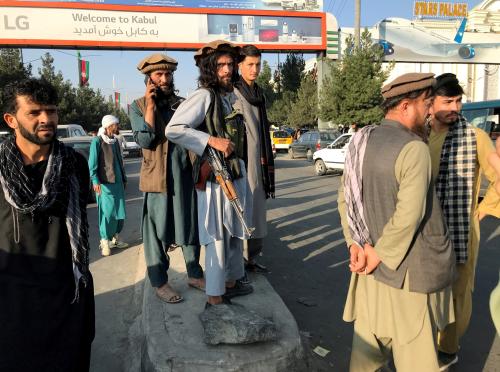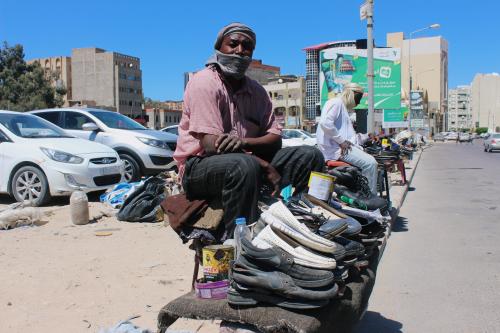Editor’s Note: This article is based on the report “Security Council, Internal Displacement Protection: Recommendations for Strengthening Action through Resolutions.” This article is part of a compilation of articles on preventing displacement, available online.
Respecting the prohibitions against forced and arbitrary displacement could significantly reduce the risk of, or prevent, displacement in situations of armed conflict, as could insisting on accountability for violations of these prohibitions that amount to war crimes or crimes against humanity. The UN Security Council has only partially addressed these issues.
During the 12-year period from 1999 (when the UN Security Council first addressed the issue of protection of civilians) until 2010, the Council adopted 747 resolutions, of which at least 142 referenced displacement with almost one in five mentioning internal displacement. But there were major inconsistencies in the way in which displacement was considered in specific country situations. While half of all resolutions on Sudan, for example, make reference to internal displacement, less than 3% of resolutions on Liberia mention displacement even though virtually all of Liberia’s 2.8 million people are estimated to have fled their homes at least once during the country’s 14 years of conflict. Some 90% of the Council’s 22 resolutions on Georgia refer to displacement while only one of the 32 Council resolutions on Somalia references displacement.
Similar inconsistencies were found in the way the Council dealt with solutions to internal displacement. Over 100 of the 142 resolutions mentioning displacement refer implicitly to some aspect of durable solutions. But among the three solutions for IDPs – return, local integration and settlement elsewhere – return has attracted far and away the most interest; only two resolutions mention local integration and six refer to resettlement.
Given the Security Council’s preoccupation with peace and security, one might reasonably have expected it to devote greater attention to prevention of displacement than to operational issues around humanitarian assistance, and indeed preventing displacement is a key element of protecting civilians which has been a laudable focus of Security Council action for the past twelve years.
And yet only 7 of the 142 Security Council resolutions referencing displacement refer to the prohibition against forced displacement – in contrast to 40 referencing humanitarian assistance and access. As forced displacement has been central to many conflicts, the fact that only four of the Security Council’s country-specific resolutions refer to forced displacement is striking.
Examples of resolutions in which the Security Council has addressed the prevention of displacement and which might provide guidance for future resolutions include:
- S/RES/1674 (2006) [Protection of Civilians in Armed Conflict] (para.5): “Reaffirms also its condemnation in the strongest terms of all acts of violence or abuses committed against civilians in situations of armed conflict in violation of applicable international obligations with respect in particular to … (vi) forced displacement … and demands that all parties put an end to such practices…”
- S/RES/1674 (2006) [Protection of Civilians in Armed Conflict] (para.12): “Recalls the prohibition of the forcible displacement of civilians in situations of armed conflict under circumstances that are in violation of parties’ obligations under international humanitarian law…”
It is very significant that S/RES/1807 (2008) [Democratic Republic of the Congo] talks of the application of targeted sanctions against those involved in forced displacement:
- “… the provisions … shall apply to … [i]ndividuals operating in the Democratic Republic of the Congo and committing serious violations of international law involving the targeting of children or women in situations of armed conflict, including killing and maiming, sexual violence, abduction and forced displacement…”
In addition in 2012 the UN Secretary-General reported to the Security Council on protection of civilians, offering it some recommendations on preventing displacement, including the possibility of referring situations to the International Criminal Court.
The Security Council could be both more energetic and more consistent in addressing the issue of preventing displacement and in the future should, on a case-by-case basis, and as appropriate, consider emphasising the following issues in its resolutions:
- reaffirm the prohibitions against forced and arbitrary displacement
- condemn violations of the prohibitions against forced and arbitrary displacement
- call for strict compliance by parties to armed conflict with:
- the prohibitions against forced and arbitrary displacement under international law
- the right to freedom of movement and residence of IDPs[1]
- call on parties to armed conflict to take appropriate measures to respect and ensure respect for the prohibitions against forced and arbitrary displacement by enforcing appropriate military discipline, upholding command responsibility, and training troops on applicable international humanitarian law and human rights law as well as the Guiding Principles on Internal Displacement and the Kampala Convention (when in force)[2], as relevant
- request peacekeeping and other UN missions to provide training to armed forces on international law relevant to forced and arbitrary displacement as well as the Guiding Principles on Internal Displacement and the Kampala Convention (when in force), as relevant
- urge states to establish legal measures and accountability mechanisms to prosecute those responsible for forced and arbitrary displacement in violation of applicable international law
- impose sanctions on persons violating the prohibitions against forced and arbitrary displacement
- request that reports of the Secretary-General on country-specific situations include information regarding the violation of the prohibitions against forced and arbitrary displacement
While the UN Security Council’s recognition of the importance of internal displacement over the last 12 years is laudable (if inconsistent), its limited attention to preventing displacement is a missed opportunity. By its own acknowledgement, the large-scale human suffering caused by displacement has implications for both future stability and further conflict. The Security Council should consistently remind states of their obligations to take all necessary measures to prevent displacement and respond to the immediate needs of, and find solutions for, those who are already displaced. More concerted and timely action by the Security Council in this regard would not only be welcome but could be considered a moral imperative.
[1] Principle 6 of the Guiding Principles on Internal Displacement.
[2] www.internal-displacement.org/kampala-convention
[3] Sanjula Weerasinghe and Elizabeth Ferris, Security Council, Internal Displacement and Protection: Recommendations for Strengthening Action through Resolutions, brookings-edu-2023.go-vip.net/research/reports/2011/09/security-council-resolutions-ferris


Commentary
The U.N. Security Council and Prevention of Displacement
December 1, 2012